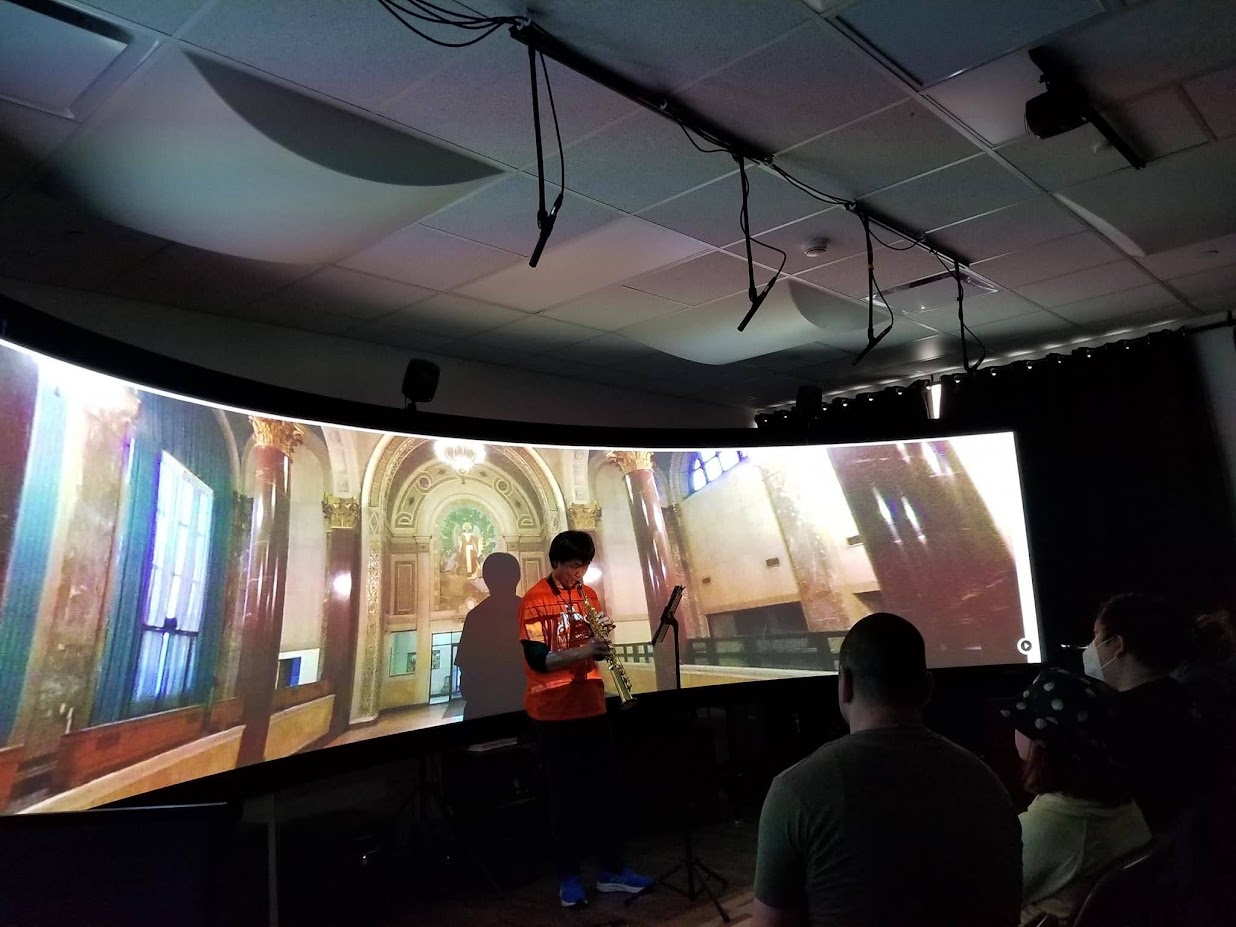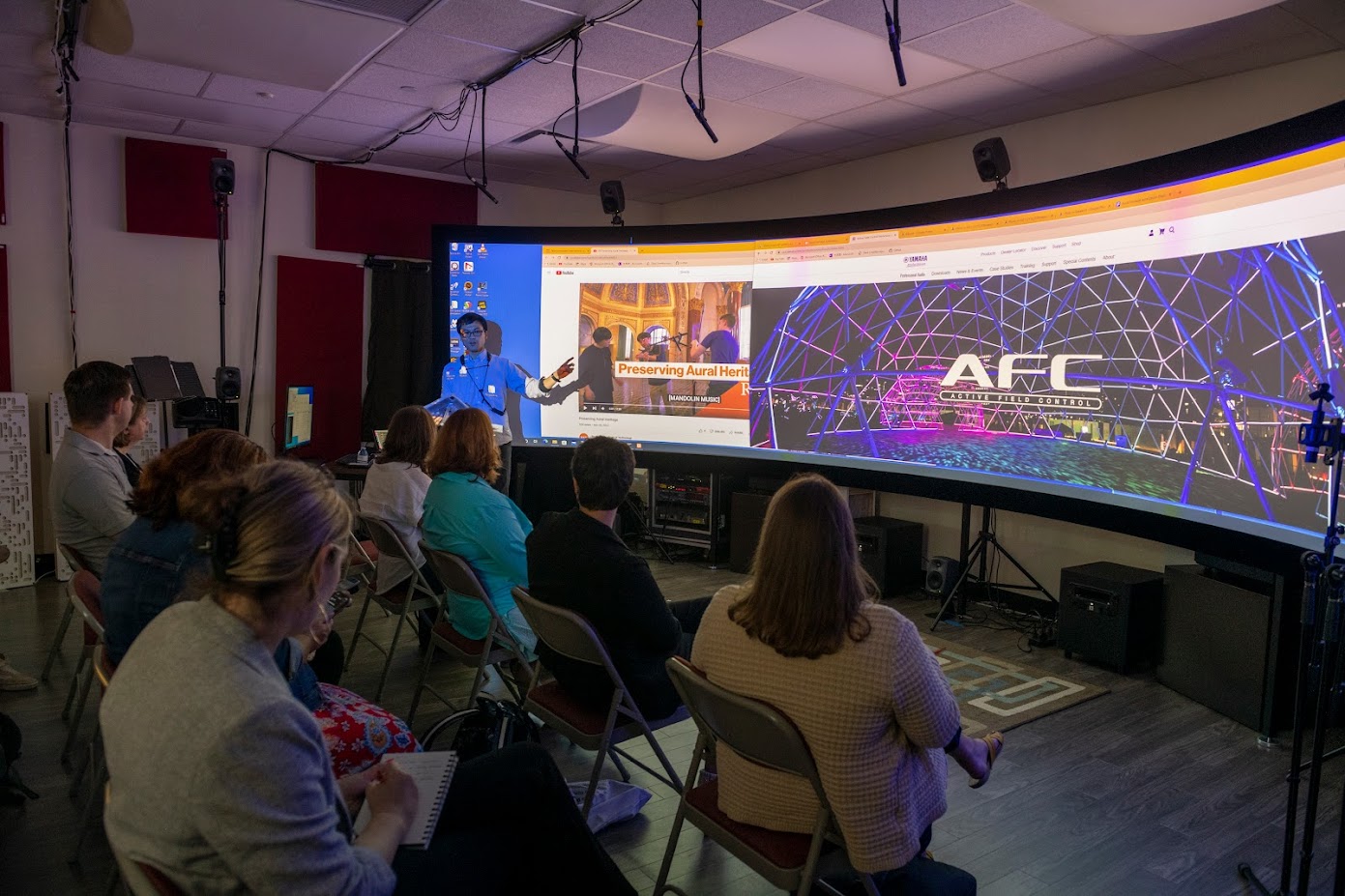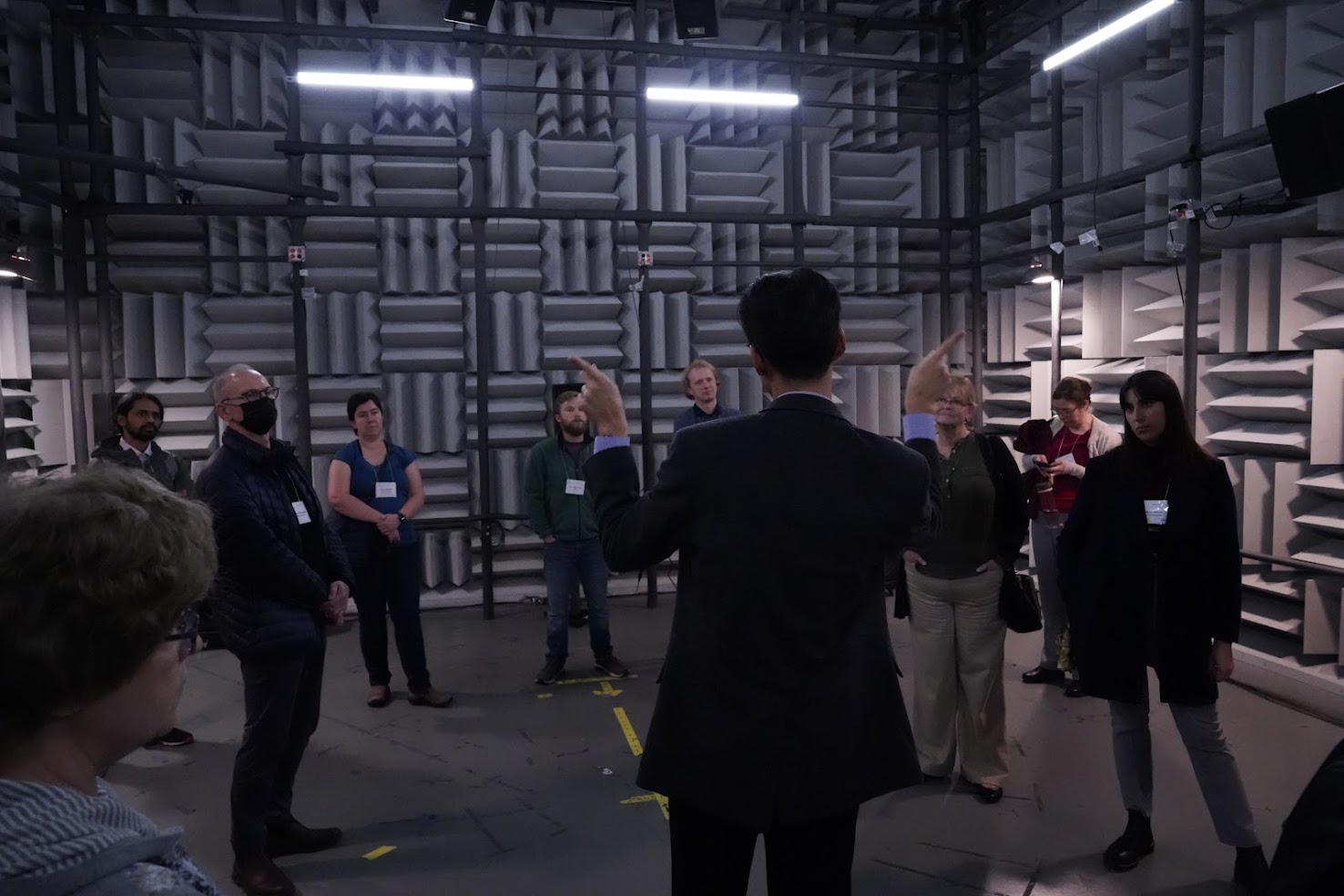Digital Preservation and Access to Aural Heritage Via A Scalable, Extensible Method
FORTHCOMING & RECENT EVENTS & PUBLICATIONS
WORKSHOP & DEMONSTRATION:
30th CIPA 2025 Symposium: Heritage Conservation from Bits: From Digital Documentation to Data-driven Heritage Conservation 23 August 2025
Conserving and Auralising Cultural Acoustics via Aural Heritage Research
Aural heritage research documents, reconstructs, and preserves the sonic interactivity of important places. We invite CIPA2025 participants to a pre-Symposium workshop at the National Museum of Korea, to learn about sonic sensory data collection and reconstruction, and to experience auralisations of places such as Columbia Studio A, a classic recording studio on Nashville’s Music Row; unique buildings from the National Register of Historic Places in the United States; religious architecture from around the world, including Korea; and the ancient instruments and architecture of the UNESCO World Heritage archaeological site Chavín de Huántar, a Pre-Columbian ceremonial center in the Peruvian Andes.
This experientially focused workshop consists of three parts: (1) theoretical and technical background on this sensory-spatial form of cultural heritage preservation, (2) demonstrations of acoustical fieldwork and virtual reconstructions of aural heritage, and (3) a special hands-on tutorial for participants to perform aural heritage data collection and create immersive auralisations. Participants will have a unique opportunity to fully experience the entire process of measuring and reconstructing of a cultural acoustical context. Furthermore, the workshop will provide attendees with the state-of-the-art VR experience of Magoksa temple, a UNESCO World Heritage Site in Korea, rendered with a focus on the aural experience of the temple’s atmosphere.
CONFERENCE PAPER:
To be Presented at The 30th ICOMOS CIPA International Symposium 2025
Place-based Virtual Reconstruction of Heritage Soundscape: A Case Study of Magoksa Temple, UNESCO World Heritage Sites of Korea Conference Forthcoming
Kyung Taek Oh, Rai Sato, Sungjoon Kim, Pooseung Koh, Sungyoung Kim, Hyeseung Shim
CONFERENCE PAPER:
To be Presented at the International Conference on Immersive and 3D Audio (I3DA September 2025) of the IEEE
Virtual Reconstruction of Historical Heritage: A 6DoF Immersive Audio-Visual Reproduction of Magoksa Temple Conference Forthcoming
Sungjoon Kim, Rai Sato, Kyung Taek Oh, Pooseung Koh, Sungyoung Kim
CONFERENCE PAPER:
To be Presented at the International Conference on Immersive and 3D Audio (I3DA September 2025) of the IEEE
Documentation Framework for Preserving Intangible Heritage: A Case Study of Korean Buddhist Temple Soundscapes
Kyung Taek Oh, Rai Sato, Sungjoon Kim, Pooseung Koh, Sungyoung Kim
EVENTS & PUBLICATIONS: GRANTED PHASE 2021 & 2022
JOURNAL ARTICLE (Open Access):
Preserving Human Perspectives in Cultural Heritage Acoustics: Distance Cues and Proxemics in Aural Heritage Fieldwork
OPEN ACCESS: Acoustics 2021, 3(1), 156-176
We examine the praxis implications of our working definition of aural heritage: spatial acoustics as physically experienced by humans in cultural contexts; aligned with the aims of anthropological archaeology (the study of human life from materials). Here we report on human-centered acoustical data collection strategies from our project “Digital Preservation and Access to Aural Heritage via a Scalable, Extensible Method,” supported by the National Endowment for the Humanities (NEH) in the USA. The documentation and accurate translation of human sensory perspectives is fundamental to the ecological validity of cultural heritage fieldwork and the preservation of heritage acoustics. Auditory distance cues, which enable and constrain sonic communication, relate to proxemics, contextualized understandings of distance relationships that are fundamental to human social interactions. We propose that source–receiver locations in aural heritage measurements should be selected to represent a comprehensive range of proxemics according to site-contextualized spatial-use scenarios, and we identify and compare acoustical metrics for auditory distance cues from acoustical fieldwork we conducted using this strategy in three contrasting case-study heritage sites. This conceptual shift from architectural acoustical sampling to aural heritage sampling prioritizes culturally and physically plausible human auditory/sound-sensing perspectives and relates them to spatial proxemics as scaled architecturally.
PANEL DISCUSSION:
Acoustics in Focus: the 180th Meeting of the Acoustical Society of America, 9 June 2021
Advances in Architectural Acoustics for Cultural Heritage Research and Preservation
2pAA Virtual Panel Discussion — Special Session in Architectural Acoustics
Organizers/Chairs: Miriam Kolar & David Lubman; Moderator: Miriam Kolar
Cultural heritage implies risk management entangled with politics of responsibility and access. We bring together leading researchers to discuss precedents, challenges and innovations in the documentation and preservation of architectural acoustics in heritage sites. Among the topics of particular interest to our discussion is the relating of acoustical data to human experience, and the strategies that panelists have used to document, estimate, and convey the perceptual significance of heritage acoustics. Panelists include ASA Fellow and archaeoacoustics pioneer David Lubman; audio engineers Brian F. G. Katz, Sungyoung Kim, Doyuen Ko; architect Pamela Jordan; soundscape researcher Francesco Aletta; and cultural acoustician Miriam Kolar, who will serve as the moderator.
PRESENTATION:
California Preservation Foundation 2021 Annual California Preservation Conference, 9 June 2021
Sense(s) of Place: Exploring Olfactory and Auditory Heritage
What does a historic place sound like? Does it have a distinctive smell? And do we have the tools to evaluate, document, and conserve these sensory character-defining features? Come make sense(s) of these aspects of cultural heritage conservation. Moderator: Trudi Sandmeier, Director, Heritage Conservation Programs, USC School of Architecture; Speakers: Doyuen Ko, Associate Professor of Audio Engineering Technology, Belmont University; Kate McLean, Artist/Designer/Researcher/Mapper of Urban Smellscapes, Canterbury Christ Church University, UK
CONFERENCE PAPER (pdf):
Audio Engineering Society
Convention e-Brief, Presented at the 151st Convention 2021 October
Perceptual evaluation of a new, portable three-dimensional recording technique: “W-Ambisonics”
In order to exploit strengths and avoid weaknesses of the First Order Ambisonics (FOA) microphone technique, we devised a new, portable 3D microphone recording technique, "W-Ambisonics." This new technique incorporates a spaced stereo cardioid microphone pair (for frontal information) with two FOA microphone arrays (for lateral, rear, and height information). In W-Ambisonics, two FOA microphones are spaced 17cm apart to capture and represent interaural cues precisely, with two cardioid microphones spaced 50cm apart, 50cm in front, which improves frontal directionality. Varying the elevation of the cardioid pair enhances spatialization techniques such as reproduction with height channels. The combination of these two microphone pairs enables the translation of recorded audio into various reproduction formats according to practical limitations in reproduction peripherals. The design focus of this technique was efficiency in the recording stage and scalability in the reproduction stage. We conducted three perceptual experiments whose results show that the W-Ambisonics method enables improved lateral localization, provides comparable sound quality to the conventional spaced array technique, and translates spacious yet precise sound images in listening evaluations of a binauralized headphone rendering. The W-Ambisonics microphone technique is practical, precise, and scalable across multiple reproduction scenarios, from binaural to multichannel systems.
JOURNAL ARTICLE (Open Access):
La Arqueoacústica experimental: Estudios para la preservación de “patrimonio auditivo” / Experimental Archaeoacoustics: Studies for Aural Heritage Preservation
OPEN ACCESS: ECOS 2022, 3(1), 42-45
Archaeoacoustical studies based in experiments made in the archaeological sites of Chavín de Huántar and Huánuco Pampa, Perú make possible the preservation of information pertinent to understanding the sonic communication possible in these sites of great Andean importance. For archaeological interpretation, we relate the physical dimension of sound with its human perceptual affordances, to make new archaeological discoveries. The new methodologies to document, preserve, and reconstruct aural heritage are applied in diverse sites including work in historical sites in the United States and in decorated caves from the Upper Paleolithic in France –– all important to the "aural heritage" record, a term that we are developing in practice and publications.
WORKSHOP PRESENTATION:
Amherst College Center for Humanistic Inquiry (CHI) Salon, 16 February 2022
Giving Voice to Social Settings: Information Ethics in Aural Heritage Research and Preservation
In this Center for Humanistic Inquiry (CHI) Salon, Amherst College Visiting Scholar (Music) Miriam Kolar shares work on documenting and preserving "aural heritage": spatial acoustics as physically experienced by humans in specific cultural contexts. For the past fifteen years, Dr. Kolar has developed site-responsive archaeoacoustics and music archaeology fieldwork in places ranging from monumental gathering centers in the Peruvian highlands to Paleolithic decorated caves in southern France. With NEH support, Kolar and colleagues are tackling the technics of aural heritage preservation for three case-study sites: Columbia Studio A recording studio on Nashville's Historic Music Row; the Byzantine-revival interior of the 1927 Rochester Savings Bank, listed on the National Register of Historic Places (NRHP); and the 3,000-year-old UNESCO World Heritage Centre archaeological site at Chavín de Huántar, Perú. However technically precise, such documentation is incomplete –– and perhaps inaccurate –– if not informed by knowledge of past events and interactions that have occurred in these places.
PUBLIC DEMONSTRATION & JOURNAL ARTICLE (Open Access):
Frameless (4)1, Discussion of Auralization Workshop-Demonstration at Imagine RIT, April 2022

Public Demonstration about Reconstructing the Aural Heritage of the Historic Rochester Savings Bank
In cultural heritage preservation, visual and architectural aspects of heritage sites are emphasized while little attention has been given to sensory and acoustic features. Because human experience is holistic, the contribution of auditory information is significant. In fact, many built environments have been specifically designed and used for conveying particular auditory information. For example, concert halls and recording studios are constructed to create pleasing acoustics for musicians and audiences. In such buildings, acoustics translate to auditory information that can uniquely identify a space. Moreover, visual information is dominant for 'informatic' experiences, while auditory information has been strongly associated with the 'emotional' aspects of those experiences, as well as with communication properties. In convincing and meaningful renderings of virtual experiences, therefore, successful delivery of auditory importation is not supplementary, but essential.
SYMPOSIUM DEMONSTRATION:
Digital Aural Heritage Project featured at RIT's Museum Studies' symposium on Cultural Heritage Imaging, Preservation, and Research (CHIPR), 15 August 2022

Demonstration of Immersive Multisensory Presentation of Digital Aural Heritage
We presented simultaneous visual reproduction of aural heritage data collection scenarios via a 250-degree wraparound screen, with 24 loudspeakers for 3D immersive audio reproduction in the RIT immersive experience laboratory.
CONFERENCE POSTER (pdf):
24th International Conference on Acoustics (ICA 2022), Gyeongju, South Korea, October 2022
Real-time spatial sound rendering system using LiDAR sensor for auditory augmented reality application
Augmented reality Room Acoustic Estimator (ARAE) is the iOS platform to compute variable characteristics of room acoustics for AR and produce spatialized sounds instantaneously using Unity and audio middleware, Wwise. This platform needs LiDAR-equipped iPhone and AirPods with gyrosensor. Participants’ movements and transmission of sounds can be stored at an external storage. Any sound attributes are controllable from both inside and outside. This research platform provides a practical experimental environment that supports a variety of studies on cognition in AAR.
CONFERENCE PAPER (pdf):
24th International Conference on Acoustics (ICA 2022), Gyeongju, South Korea, October 2022
Influence of the presence of congruent visual media on spatial auditory fidelity
In this research, we investigated the influence of congruent visual media on the recognition of spatial audio attributes in a multimodal virtual reality context. For the immersive auditory data, we recorded solo piano music using three multichannel microphone techniques: a 5-channel conventional surround microphone technique, and a 7-channel and a 9-channel immersive microphone array that both include height-channel microphones. In total, 38 normal-hearing participants were invited to the experiment and separated into two groups for presenting immersive audio with and without congruent visual media. The visual data was collected using a 360-degree camera and projected to a 250-degree wraparound screen for immersive visual rendering. Participants were asked to rate the timbral and spatial attributes for each of the three immersive auditory presentations (solo piano music via the three multichannel recording techniques), and to provide an overall preference rating by using a continuous quality scale (CQS). Experiment results show that the presentation of congruent visual media modulates reported perceptions of auditory attributes from simultaneously presented immersive audio. The experiment demonstrated that the presence of a realistic visual image congruent to the presented auditory material made listeners require higher spatial auditory fidelity in the immersive multimodal context. Consequently, this study's findings can be used to inform immersive and holistic audiovisual and interaction design.
PEER-REVIEWED CONFERENCE PAPER (pdf):
24th International Conference on Acoustics (ICA 2022), Gyeongju, South Korea, October 2022
A "human-centered" approach to aural heritage preservation and access
Aural heritage research documents, reconstructs, and preserves the sonic interactivity of sites important to humans across time and around the world. Here, we discuss acoustical data acquisition per the definition of aural heritage we proposed: "spatial acoustics as physically experienced by humans in cultural contexts." Two factors support ecological validity (realism). First, the use of places change over time, so aural heritage documentation and reconstruction should be informed by contextual knowledge of both present-day situations as well as past scenarios suggested by historical records or archaeological materials. Second, and our focus here: aural heritage documentation requires acoustical measurements that represent humanly plausible perspectives on a soundfield, including measurements that document human-surface relationships. To ensure accuracy in the presentation of reconstructions of past acoustics to present-day humans, it is necessary to understand how spatial acoustical data translate across different audio rendering systems used for auralizations. Our "human-centered" approach to data collection addresses ecological validity in aural heritage preservation, and in concurrent research we have conducted perceptual evaluations of soundfields reconstructed from these data in multichannel listening rooms. Aural heritage data collection and auralization research require separate methodologies that intersect in the presentation of past acoustics to present-day listeners.
PUBLIC DEMONSTRATION:

Acoustical Society of America Meeting Tour at Belmont University, 8 December 2022
Demonstration of Multichannel Audio Presentation of Digital Aural Heritage
We presented aural heritage data via 3D immersive audio reproduction in the semi-anechoic chamber at Belmont University’s Curb College of Entertainment and Music Business.
CONFERENCE PAPER:
183rd Meeting of the Acoustical Society of America, Nashville, TN, 5-9 December 2022
Presentation in the Special Session Sound With Context: Cultural Heritage Acoustics
Aural Heritage Preservation and Access: Methodological Explorations from Data Collection to Immersive Multimodal Virtual Reality
From prehistorical archaeological sites to middle-American banks, classic Nashville recording studios, and present-day concert halls, spatial acoustics influence human experience, behavior, and interactions. We previously proposed a definition of aural heritage: "spatial acoustics as physically experienced by humans in cultural contexts," and have tested equipment and methods to document aural heritage in diverse sites. In fieldwork and in the studio/lab we have evaluated and extended standard room acoustics techniques to address ecological validity (realism) in aural heritage preservation including specific human-centered methods. For translation of aural heritage data into auralizations, we have focused on multichannel audio with and without congruent visual immersion, anticipating multimodal virtual reality presentations of cultural heritage reconstructions. Here, we overview our multi-year project to develop, test, and share aural heritage preservation, translation, and access technologies via three detailed case study applications and associated outreach projects. We 1) summarize the translatable aural heritage data collection protocol for long-term preservation; 2) discuss preferred methods for processing aural heritage data into scalable auralizations for different audio platforms; and 3) preview extensibility pathways for other researchers to implement these methodologies that enable researchers and public audiences to explore and experience this aspect of intangible culture.
GRANT REPORT:
White Paper for NEH Grant# PR-263931-19
Digital Preservation and Access to Aural Heritage Via a Scalable, Extensible Method
Aural heritage research documents, reconstructs, and preserves the sonic interactivity of sites important to humans across time and around the world.
Project co-organizers Kim, Ko, and Kolar proposed and developed a methodology for aural heritage preservation and access based on our working definition of aural heritage: “spatial acoustics as physically experienced by humans in cultural contexts” (Kolar et al. 2021).
This project was formed to develop, test, and share aural heritage preservation, translation, and access technologies via three detailed case studies and associated outreach, including publications and demonstrations.
Developing our digital aural heritage research, preservation, and access protocol via consecutive case studies enabled us to evaluate our initial assumptions and refine our methodology between fieldwork and laboratory development, then back to the field, with interspersed presentations and community interactions, to share the work-in-progress with those outside our team. Monthly meetings among the three co-organizers enabled us to collaboratively advance on project goals. The project structure and timeline that we designed required that we develop our research iteratively, with opportunities for feedback from colleagues as part of our regular and ongoing participation in conferences, presentations, and conversations with our Advisory Board. Presentations to scholarly and public audiences also provided feedback from diverse constituencies that we took into consideration as we progressed through the case-studies, produced documentation on our research, and further tested the protocol in two additional and unplanned case-study cultural heritage sites.